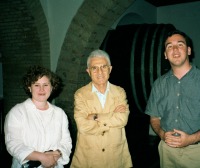To paraphrase something that Fury wrote this weekend: if there is anything more exciting than boiled dinner, it’s making boiled dinner; and if there is anything more exciting than making boiled dinner, it’s blogging about making boiled dinner. “Lucky you!”
Ah, but the line between New England boiled dinner and a celebratory corned beef and cabbage is very fine—mostly it depends on the presence or absence of horseradish and turnips, apparently. And on the weekend before St. Patrick’s Day, we decided to cheerily conflate the two. So, having packed Lisa and her mom off to the New England Flower Show, I started getting things ready.
I had a few other things I wanted to cook at the same time. We had roasted a chicken the previous night, and I wanted to get rid of its carcass (plus the other two carcasses in the freezer) by making stock. Also, Lisa’s dad had put in a request for Boston brown bread, which turns out to be made by steam-cooking a can filled with batter consisting of graham flour, cornmeal, and rye flour (mixed with buttermilk, molasses and baking soda) for several hours. So that turned out to be three large stockpots atop a stove that could really only comfortably fit two.
I started the stock first (dead easy, incidentally: tie a carrot, several parsley stems, a celery stalk, and bay leaf together with cooking twine; add an onion in large chunks; throw in whatever chicken bones and odd scraps you have handy; cover with water; simmer for several hours, skimming as you go; remove the solids and simmer a little longer to concentrate the stock and skim off any remaining fat) and then got the bread steaming. Somewhat to my surprise, the bread came out beautifully, sliding out of its can (I used a butttered pannetone mold covered with foil) with no resistance, and just needing a few minutes in a 350º oven to firm up the sticky top.
So that was one big boiling pot off the stove, leaving enough room to start the boiled dinner. Which was good, since the recipe I consulted suggested simmering the corned beef for five hours and it was almost 1 pm. I plopped two corned beef briskets (thank you, Costco, for cheap meat) and their spice packets in a big stockpot, covered with water, and brought the thing to a boil, then backed it down to a simmer. And that’s all I really did, except for pouring a can of Guinness into the pot an hour in.
The beautiful things about the meal were: 1) the boiling. On a wetly snowy winter day, as many things should be boiled as possible; 2) the lack of interference needed. I was able (with Lisa’s dad’s assistance) to remove a door that normally goes sticky in summertime when it swells with humidity and get the bare wood top and bottom of the door painted, hopefully mitigating the problem, while the corned beef (and my stock) simmered; 3) the flavor. The vegetables, added in the last hour or so, were good, but the corned beef was spectacular—falling-apart moist and flavorful without being overly salty. And Lisa declared the Boston brown bread her new favorite.

